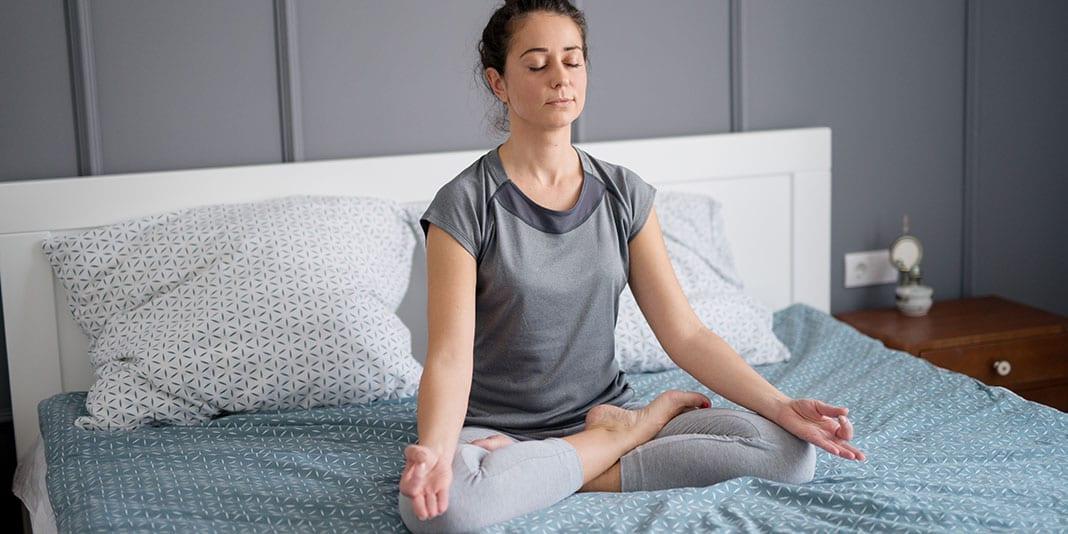Mindfulness – the concept of focusing one’s awareness on the present moment – is all the rage these days. The idea has been translated into every facet of life from mindful meditation (naturally) to mindful parenting, mindful networking, and more. But what about bringing mindfulness into the bedroom? Leave your regular, solo-practice of meditation at the door, grab a partner, and dive into the world of Orgasmic Meditation(OM), a goalless practice that focuses on the clitoris, and has reported benefits ranging from reduced stress and irritability to increased vitality, libido, energy, and confidence.
OM is a movement, and at its head is Nicole Daedone, author, consultant, and founder of OneTaste, an online hub for all things orgasmic mediation. At OneTaste you can learn more about the practice, get an “orgasm diagnosis,” find OM events near you, connect with other OM-ers, and even watch a how-to video. Beyond the website, OM can be learned in a variety of ways. Just like yoga or traditional meditation, you can opt for group classes, workshops, retreats, or even private lessons. But, unlike yoga, OM’s focus is on a specific part of the body – the clitoris – leading many to be intrigued with this new trend, like Gawker’s Nitasha Tiku, who wrote about her time with what she dubbed the “Thrill Clit Club” last year.
The practice itself is rather straightforward. One person focuses on the movement and sensations from their left index finger, which strokes the upper left corner of their partner’s clitoris. The partner focuses their attention on their clitoris and the feelings brought up there. Both people focus on the point of connection. The stroking lasts a full 15 minutes, with the point being to focus on the feeling, not to necessarily achieve orgasm. It’s simple in theory, but getting started with the practice can come with a set of challenges not found in your average meditation class.
Karin, a 40-year-old marketing manager from California, has been with her partner for 15 years. She had heard about OM from a friend, and was intrigued about the different take on the concept of orgasm. She liked the idea of learning more about her body and what it is capable of doing. Karin hoped that OM could also add some more “spice” to her sexual relationship, and decided to have a private lesson with her husband and a trained OM instructor. Despite her excitement and interest in the practice, Karin still had some slight hesitations, particularly about having someone in the room watching her husband intimately touch her.
Karin said that it helped that her OM trainer chatted with them via Skype for an hour-long consult where they were able to have all their questions answered about their in-person session. Their trainer also sent them some reading material to review before the actually began their OM practice. Then, one Wednesday morning once the kids were off to school, their trainer arrived to guide Karin and her husband them through their OM experience. “It was strange to have someone in the room, telling my husband what to do,” Karin explains of her first OM. “But she was very loving, and I was never uncomfortable.”
READ MORE: Why Women Have Orgasms
Given the intimate nature of OM-ing, a private lesson may seem like the best method for some, but many people also learn the practice of orgasmic meditation in a group setting. Like Karin, Reba, a divorced mother of two from New England, had also heard about OM from a friend and decided to give it a shot. “I really loved the idea that the experience was about surrendering to your own sexual pleasure, that a woman’s sexual experience could be for her to enjoy without any expectation of returning any pleasure,” she explained. It also appealed to her as someone recently back in the dating scene after years of marriage. ” [OM] seemed really honest,” Reba told me. “Why play all the games that often lead to sex, when you could just say, I want [what] feels good for me.”
Reba ended up attending a workshop, without knowing anyone else there. One of her biggest hurdles was getting over the fact that she was about to allow a stranger to touch her intimately. “Going to a bar, meeting and going home with a stranger is more socially acceptable than having a person you’ve never met before stroke your clitoris for fifteen minutes in a room full of people,” Reba said. “I had to get over that dynamic in my own head. As much as I accept it intellectually, it was still a big leap to actually do it.”
After hearing more about the practice and its benefits, Reba and the rest of the workshop attendees watched a couple OM in front of them. They were then given the option of practicing themselves. Reba said that it then became less about the stranger factor and more about surrendering to the idea that her own sexual pleasure is both worthwhile and meaningful. In the end, she partnered up and OM-d.
Despite coming to OM differently, both Karin and Reba found similar results. “Days after our training session, my husband and I did our first OM – just us – and it was incredible. We will do it again and again and again,” said Karin. She said that while the practice is still new to them, she can already feel a “deeper intimacy” with her husband. As for Reba, she said she would definitely do it again, she just needs some partners to practice with. According to her, OM was “…electrifying, scary, awesome!”
READ MORE: The Path is “The Apple Store for Meditation”
Both Reba and Karin were turned on to the practice of OM, and said they hope to incorporate it into their lives more often. And they’re not alone.
“I’ve been OM-ing everyday for about 16 months now, and it’s the best thing I ever did for myself,” said Family Physician and OM practitioner Radha Lewis. “It’s like a 15 minute recharge of my battery. My whole system feels renewed, recharged and saturated, and I have energy to go out into the world and be generous toward other people and be kind to other people.”
Dr. Lewis had known about OM for a while before finally exploring it for herself. She found herself quickly hooked, and in addition to practicing herself, she also teaches private OM trainings. From a medical standpoint, Dr. Lewis stresses the multitude of health benefits that accompany a regular OM practice. “One thing that’s happening is activation of the parasympathetic nervous system,” she explained. “For most people it tends to be a rejuvenating practice. We live in a world where the sympathetic nervous system is constantly being stimulated, and there are very few processes to bring down the sympathetic and bring up the parasympathetic, and this is a process like that.” Dr. Lewis also notes the importance of intimate touch, which is a central focus with OM. “Intimate touch and connection between people creates a rise in oxytocin,” she said. “Oxytocin is a hormone in the brain that has people feeling more connected with one another, more empathetic toward one another, more trusting. It’s something that all mammals have, it’s wired into our systems so that we are able to deal with the world together in groups. We live in a world where what’s exalted is isolation, while what we require biologically is connection.”
In theory, OM sounds like one more additional mindfulness tool – to keep alongside yoga and meditation. Yet the practice is also fighting up against years of repressed sexuality and ingrained puritanical structures. Orgasm and sexuality – especially when focused on women and their desires – can easily slide into shameful and stigmatized territory. Will OM, and it’s increasing popularity, be the trend that helps break down these stereotypes and stumbling blocks when it comes to the way we talk about and experience orgasm and pleasure? Many think so, including Dr. Lewis, who feels that people just need to experience OM to move past that mindset to discover something new and potentially revolutionary.
“We live in a world where sexuality is something we don’t talk about, and it’s something that’s kept behind closed doors and is surrounded with darkness and secrecy,” she said. “I think that getting over that first piece is the hardest for pretty much everybody. Once someone says yes to learning, then it’s fun. It feels good and it’s fun.”
READ MORE: Meditate for Stress Relief



































